 Although there has been a lot of attention paid to our milfoil issues, there are many other threats to our lake. While additional aquatic invasives would present another significant issue, an ever increasing threat is the potential for longer and more frequent cyanobacteria blooms. These can easily destroy the recreational value of the lake and pose a health hazard for people and animals alike. Cyanobacteria blooms are a looming problem for many lakes. Two prime causes are nutrients, particularly phosphorus, entering the lake and also our gradually increasing average water temperatures. This excellent webinar, presented by Amy Smagula from NH DES, explains the issues and impacts. Link to it here.
Although there has been a lot of attention paid to our milfoil issues, there are many other threats to our lake. While additional aquatic invasives would present another significant issue, an ever increasing threat is the potential for longer and more frequent cyanobacteria blooms. These can easily destroy the recreational value of the lake and pose a health hazard for people and animals alike. Cyanobacteria blooms are a looming problem for many lakes. Two prime causes are nutrients, particularly phosphorus, entering the lake and also our gradually increasing average water temperatures. This excellent webinar, presented by Amy Smagula from NH DES, explains the issues and impacts. Link to it here.
Author: Neil Santos
Fall Road Cleanup Manages with Skeleton Crew
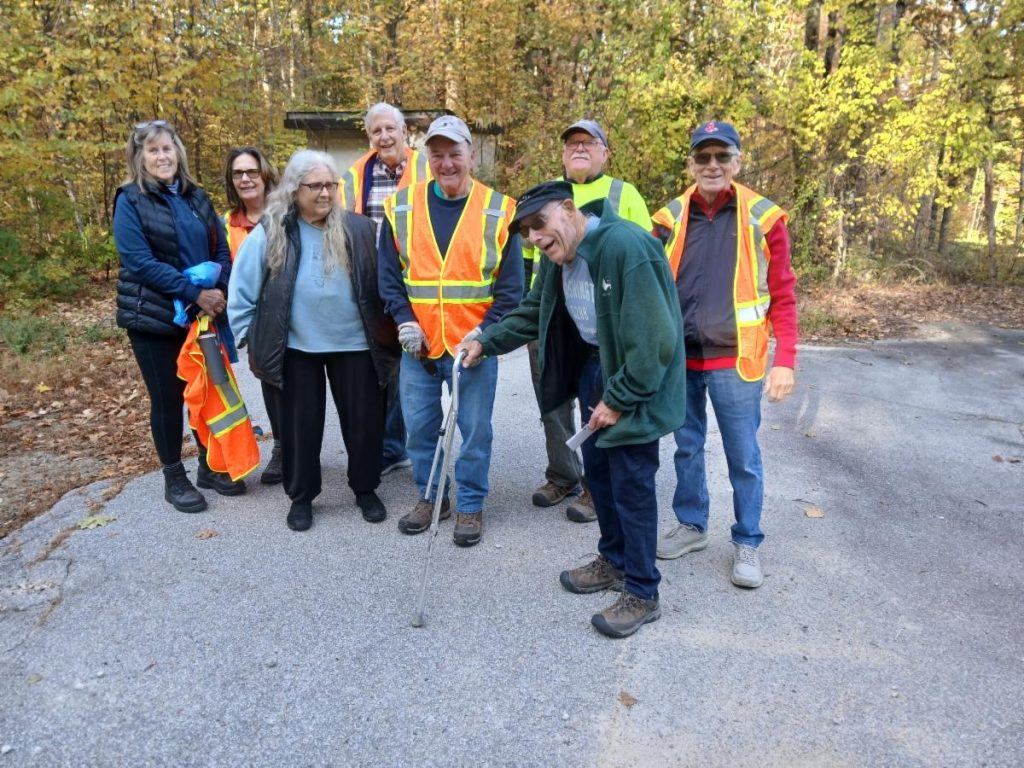 Here is organizer Pete Wawrzonek’s report: Given the robust participation we have been used to getting, it was a sparse turnout of volunteers for the Road Clean Up event on Sunday morning, October 19. Since we were so short staffed, it was essential having Steve Soreff and Therese Thompson handling some of the required paperwork and monitoring work assignments.
Here is organizer Pete Wawrzonek’s report: Given the robust participation we have been used to getting, it was a sparse turnout of volunteers for the Road Clean Up event on Sunday morning, October 19. Since we were so short staffed, it was essential having Steve Soreff and Therese Thompson handling some of the required paperwork and monitoring work assignments.
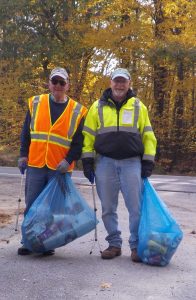
It was challenging for the eight remaining volunteers to gather litter along our assigned stretches of Route 156, but our crew was up to the task. With their usual enthusiasm and good cheer, everyone present gladly did two sections of road
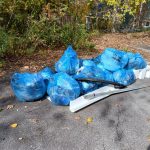
All in all, we collected 16 bags of trash and 8 bags of aluminum cans,along with a massive tarp and numerous car parts.
.
Thanks to all who turned out for this community service, making our town cleaner and safer!

Last PLIA Road Cleanup for 2025
ARE YOU STREET SMART?
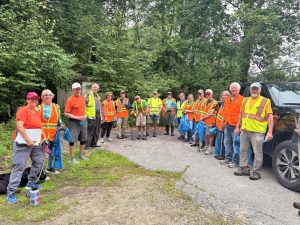 If you’d like to be, join us on Sunday, October 19, 2025, at 9:00 AM.
If you’d like to be, join us on Sunday, October 19, 2025, at 9:00 AM.
The PLIA is scheduling the last road clean up of the year, so this is the perfect time to show that roadside litter who’s boss!
Three times a year, PLIA volunteers gather at the Comcast Communications shed on Route 156 near Seamans Point Road. They get their assignments from organizer Pete Wawrzonek and head to their section of roadway with a friend, neighbor, or fellow volunteer. Bags and reflective vests are provided, but gloves and sturdy shoes are also recommended.
Those who wish to do so are encouraged to separate out cans for recycling – there will be plenty of bags for that purpose. Vacationers and careless revelers have been busy tossing trash out their car windows all summer, so now’s our chance to gather it up before it leeches pollutants into the soil, and before it is hidden by winter snows.
Most everyone’s boat has been taken out for the winter and the water is pretty cold for swimming, so people are not so busy having fun on the lake. We can offer you outdoor recreation!
Let’s make this last road clean up the best yet; the more people who show up, the faster the job will get done!
STATE ANNOUNCES ITS 2025 FALL DRAWDOWN OF LAKES
Drawdown schedule will take drought conditions into account
The New Hampshire Department of Environmental Services (NH DES) announced yesterday that the annual fall drawdown of the lakes and ponds controlled by dams owned by NH DES will be initiated according to the schedule detailed on the NHDES website. As of now, Pawtuckaway Lake’s drawdown is scheduled tentatively for October 13, 20205.
Lake drawdowns are conducted each fall to reduce winter ice damage to shoreline properties and to reduce spring flooding. Drawdowns also give property owners an opportunity to conduct any necessary repairs to their waterfront property, provided they first secure a permit from the NHDES Wetlands Bureau at (603) 271-2147.
Due to the ongoing drought conditions across the state, the drawdown dates could be adjusted to a later date considering lake and river levels at the time of the drawdowns.
Additionally, the final depth of the drawdowns from full level could be reduced to ensure refill is reached following spring runoff.
C. Wayne Ives, P.G., Hydrogeologist and Instream Flow Specialist, NH DES, adds the following caveat:
“Because of the low starting water level of Pawtuckaway, the starting date is likely to be later than the stated October 13 date. And because of the rain last week and this weekend the date may shift further as Dam Bureau tries to follow the usual track. I estimate they may start the drawdown as late as October 21. When I learn more, I will let you know.”
Arlington Pond Takes Action on Invasives
Arlington Pond in Salem, NH is infested with 3 invasive plants; milfoil, fanwort, and brittle naiad. This article from the Derry News reports on what actions they are taking to reclaim their lake. Read the full text here.
Urgent Milfoil Update
Milfoil Team Coordinator Neil Santos addressed the Nottingham Select Board at its meeting on October 6, 2025. PLIA Board members Tom Duffy, Shelly Heit, Pete Wawrzonek, and Pam Kelly were also present.
Neil’s presentation concerned the current status of milfoil infestations on Pawtuckaway, which in recent months have multiplied at the north end of the lake. He reported that NH DES conducted a survey last week and discovered even more milfoil infestations.
Neil’s slideshow illustrated the locations and density of milfoil, especially in the shallows of the Fundy. He explained how its proliferation had gotten beyond the capacity of PLIA volunteers to locate and extract it, despite having already dedicated 720 hours to that effort. Professional divers have had to be hired to supplement volunteers’ efforts. He emphasized that the Fundy is a major traffic channel of transport for motorized boats, because the public boat ramp there is the busiest in the State. When plants in that channel are broken up by the force of propellors, they spread quickly.
For the most part, the team of PLIA volunteers has been concentrating on removal in the south end of the lake. This is primarily because weed control is more feasible there, while the weedy and silty, extremely shallow nature of the north end makes removal near impossible. Those hours do include search and removal in the north end as well, however.
Neil stressed the need for help, likely in the nature of herbicide application in the Fundy, an area covering at least 50 acres. NH DES would decide the nature and extent of a permit for this kind of operation. He estimated that the cost would approximate $50,000, and he outlined the potential sources of funding for such a project. Principally there would be a grant request from NH DES, but the most that could be expected from that agency would be $25,000.
His purpose was to inform the Select Board about the situation and let them know that the PLIA will return for a request for money after securing other sources of funding and learning what the DES will recommend for action. Neil anticipated a contribution of $10,000 from the PLIA and hopes to be able to tap Nottingham’s Invasive Species Fund for at least $15,000. There is a balance of $87,00 currently in that fund. Finally, he said the PLIA will investigate possible funding from the Lamprey River Advisory Committee (LRAC) and continue to make a case to the State Park system for money to alleviate this threat to the lake. The Select Board might make a request to the State Park on behalf of the Town as well.
Also attending the meeting and speaking to the Select Board were PLIA Members Jamie Burleigh, Dan Davis, and Therese Thompson. The latter two are also on the Lamprey River Advisory Committee. Dan reminded everyone that phosphorus in the lake is a larger threat, as it feeds both milfoil and cyanobacteria blooms. Neil responded that the PLIA is pursuing another grant to provide data to support the funding of projects to alleviate phosphorus loading. Therese suggested that milfoil removal on Pawtuckaway is crucial to prevent it from escaping into the Lamprey River. Jamie advised the group that lowering the lake level would do nothing to kill milfoil, since it can revive after years of being left high and dry. See the full presentation here.
Pawtuckaway Games Recap
On Saturday afternoon, September 13, 2025, Pawtuckaway Lake was the scene of hilarity and excitement. From 1:00 – 4:00 PM, a group of enthusiastic players competed in the PLIA’s FIRST Annual Pawtuckaway Games event. There were contests and challenges presented to pairs of participants – on a timer, no less – at five properties along the shore of the lake.
To say the least, spirits were high as teams completed seemingly impossible tasks. One competitor summed up her experience like this:
“I do not live on Pawtuckaway Lake but for me it is full of childhood memories. More were created today.
Ever try to fill 6 plastic cups with air from a balloon in order to lift it with nothing but air – and build a pyramid with them?
Ever lug buckets full of lake water with holes in the bottom and dump it into another bucket with the hope of floating a rubber “duckie” out?
How about trying to open a Russian-egg type package with many inner packages while wearing Oven mitts? (At the Ovens’ – of course !)
Now you may have more experience with cornhole or puzzles. Any good Laker brings some skill to these. But do it with a timer going???
My partner and I did not go away with any trophies. (Clearly cornhole does not need a strong pitch.)
But when was the last time you spent a Saturday afternoon just playing games just for the fun of it?
Nice job by Lamprey 18-30! The Lake and its neighborhood benefited.
And we created another great memory on Pawtuckaway Lake.
A good time had by all.
Thanks,
Monica A. Joyal”
Thanks for the testimonial, Monica, and thanks to our volunteer organizers for this wonderful opportunity to celebrate our lake community and raise money for the PLIA at the same time.
And, see you on the lake!
SepticSmart Week
Yes, it’s a thing!
September 15 – 19 is national SepticSmart Week, which was established to emphasize how important it is to take proper care of your septic system.Erin Mastine, Outreach Manager at NH LAKES, has sent a special news blast inviting all lake lovers to be part of it. We who live or vacation on Pawtuckaway Lake should heed the call!
Here is Erin’s message:
“Taking care of your septic system isn’t just about preventing unpleasant backups in your home. Failing systems can leak nutrients and bacteria into nearby water sources, contributing to harmful cyanobacteria blooms and other water quality issues in the lake you love.By maintaining what’s underground, you’re helping to protect what’s above—our clean, healthy, and beautiful lakes.
Keep reading for simple steps you can take to care for your septic system—and make a lasting difference for New Hampshire’s lakes.”
Schedule Regular Inspections and Pumping
Have your septic system thoroughly inspected—including tanks, valves, and leach fields—by a licensed professional every three years at a minimum. This helps uncover hidden issues before they become costly disasters.
Practice Water Conservation
Spread out laundry and dish loads, install low-flow plumbing fixtures, and turn off water when brushing teeth or lathering
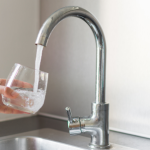
up. Small changes can reduce strain on your system.
Respect Your Drainfield
Don’t park vehicles or build structures over the drainfield. Also, avoid planting woody vegetation
within 10 feet—roots can damage underground components.
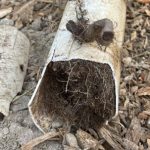
Be Mindful of What You Flush or Pour Down the Drain
Only toilet paper should go down the toilet. Avoid pouring fats, oils, paint, bleach, and other chemicals down the sink. Compost food scraps rather than using a garbage disposal.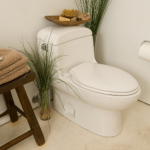
Keep Systems Accessible
Keep the area above your septic system easily accessible for inspections and pump-outs. Think of it like blending usability with a neat, manageable landscape.
Lake Kanasatka Pursues Solution to Toxic Cyanobacteria
 Lake Kanasatka has had a critical issue with cyanobacteria over the past several years. In one case the toxic bacteria was present for almost half a year. They raised funds and pursued treatment with the spread of alum to bind the phosphorus that is the primary cause of the blooms. You can read the full article from the Boston Globe here.
Lake Kanasatka has had a critical issue with cyanobacteria over the past several years. In one case the toxic bacteria was present for almost half a year. They raised funds and pursued treatment with the spread of alum to bind the phosphorus that is the primary cause of the blooms. You can read the full article from the Boston Globe here.
Party on the Point II
Pawtuckaway residents were treated to a lively summer concert from 4:00 – 7:00 PM on Saturday, August 30. Over thirty boats and countless kayaks, paddle boards, and canoes convened at a point of land on the south end of the lake to enjoy JD Ingalls’ vast repertoire of musical numbers.
PLIA Fundraising and Membership Chair Shelly Heit ventured out on her paddle board going boat to boat as she welcomed people in the audience with a gentle reminder about the PLIA.
On land during intermission in the program, Shelly announced that the event was sponsored by the PLIA to celebrate the spirit of our lake community. She encouraged attendees to join, renew their membership, or make a donation to the tax-exempt PLIA. Our fee-free payment platform, Zeffy, is the easiest way to do that, and you can access it here.
Funding of milfoil prevention and removal programs are big priorities for our lake association.